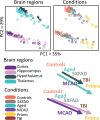Reactive astrocytes in prion diseases: Friend or foe?
- PMID: 38900746
- PMCID: PMC11189187
- DOI: 10.1371/journal.ppat.1012286
Reactive astrocytes in prion diseases: Friend or foe?
Conflict of interest statement
The authors have declared that no competing interests exist.
Figures


References
Publication types
MeSH terms
Substances
Grants and funding
LinkOut - more resources
Full Text Sources

